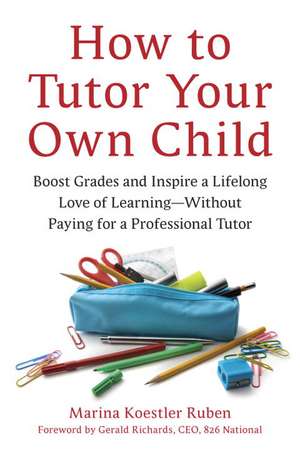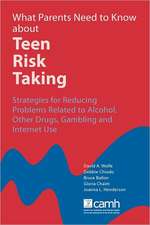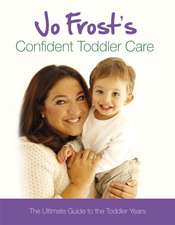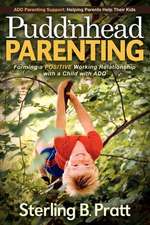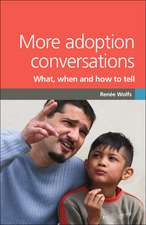How to Tutor Your Own Child: Boost Grades and Inspire a Lifelong Love of Learning--Without Paying for a Professional Tutor
Autor Marina Koestler Ruben Gerald Richardsen Limba Engleză Paperback – 31 iul 2011
Top professional tutor Marina Koestler Ruben empowers you to take a do-it-yourself approach to your child’s after-school enrichment. As a parent-tutor, you will learn how provide holistic academic support for your children and create an intellectual environment in the home—strengthening your relationship and improving parent-child communication in the process.
Ruben’s accessible guide shows you how to balance big-picture curiosity with the academic nitty-gritties of homework assignments, organization, and electronic resources. Building on her proven “Six-Step Session” format, Ruben shares the secrets to tutoring children in any subject from kindergarten through high school—all with a warm, entertaining tone that will inspire you to inspire them.
Preț: 106.45 lei
Nou
Puncte Express: 160
Preț estimativ în valută:
20.37€ • 21.38$ • 16.91£
20.37€ • 21.38$ • 16.91£
Carte disponibilă
Livrare economică 20 martie-03 aprilie
Preluare comenzi: 021 569.72.76
Specificații
ISBN-13: 9781607740278
ISBN-10: 1607740273
Pagini: 198
Ilustrații: ONE COLOR
Dimensiuni: 137 x 206 x 15 mm
Greutate: 0.23 kg
Editura: Ten Speed Press
ISBN-10: 1607740273
Pagini: 198
Ilustrații: ONE COLOR
Dimensiuni: 137 x 206 x 15 mm
Greutate: 0.23 kg
Editura: Ten Speed Press
Notă biografică
Marina Koestler Ruben, MA, is a professional tutor, writer, and editor who works as the official in-house writing tutor at the renowned Sidwell Friends School. She has also privately tutored students K–12 in math, science, history, English, ESL, French, Spanish, and other subjects. She has been published by the Washington City Paper, Smithsonian.com, CNN.com, EducationWeek.org, and McSweeneys.net, and she has appeared on NPR’s Talk of the Nation. Marina lives with her husband and daughter in Washington, DC. Visit www.MarinaRuben.com.
Extras
Foreword
Parents, let me tell you two things. First, your children think you’re amazing. Seriously. You may not think so and they may not say so (at least until they turn twenty-five or thirty) but they do. Second, you were your child’s best teacher. You taught them right from wrong and how to tie their shoes. I say were because around first grade you were replaced. Replaced by Ms. Dunbar in the first grade or Mr. Silver the hip English teacher—and that’s okay. It provides you with the opportunity to take on another role in your child’s education, that of tutor. Your child listens and pays attention to everything you say or do. So it’s only natural that your child learn about Ptolemy, practice quadratic equations, and recite Shakespeare’s sonnets with you. Marina Koestler Ruben wrote this book to show you how.
At our 826 tutoring centers, we have over five thousand volunteers who work with our students every day. They help students with math, reading, and writing. For various reasons, many of our students’ parents don’t have the time or the capacity to help their children. Our volunteer tutors provide these students with a caring adult willing to spend a couple of hours of their time working with a young person on their homework. It means the world to our students to have someone spend that much time where the spotlight is on them, what they are working on, and how they can be helped. We provide training to our volunteers because tutoring can be scary. Having that young face look at you hoping you have all the answers can be an intimidating experience. We work to make tutoring fun and simple so that the tutor and the student both have the best experience possible.
I remember my first tutor. I was (and kind of still am) horrible at math. I scored a 275 on the math portion of my SATs. 275. I wasn’t going to get into a good college—in fact, I worried I might not even get into college. My school assigned me a professional math tutor, a stodgy, socially awkward man—who smelled. But he was a great tutor. He was knowledgeable, very tough, and very patient. After two months of tutoring, I scored a 400. Not perfect, but a score that got me into a great college. I know the difference tutoring can make in a life.
This book empowers you to become the tutor, that additional teacher your child may need to achieve educational success. It provides you with positive reinforcement to let you know that you don’t have to be a Rhodes Scholar to help your child prepare for a chemistry test. You just need the time and the desire. I know you have both. This book provides you with the tips and tools you’ll need to make tutoring your child an enjoyable experience for you both. Learning doesn’t have to be confined to school. It can take place in the kitchen, the dining room, or the backyard.
A PhD is not required to help your child learn. There’s no mystery or secret sauce. Your child already thinks you’re amazing, and being your child’s tutor is just another sign of how great you are. Marina is giving you her secrets and her years of experience. She has given you tips and demystified the process. You have decided to become not just a parent but also that caring adult all children need. Have fun!
Gerald Richards
CEO
826 National
826 National is a network of nonprofit organizations cofounded by Dave Eggers and dedicated to helping students, ages six to eighteen, with expository and creative writing, and to helping teachers inspire their students to write. 826 chapters are located in San Francisco, Los Angeles, New York, Chicago, Ann Arbor, Seattle, Boston, and Washington, DC. Our mission is based on the understanding that great leaps in learning can happen with one-on-one attention, and that strong writing skills are fundamental to future success.
Introduction:
The Best Tutors I Never Knew I Had
The first time I tutored, I had déjà vu. I was a high school student, and Suji, the girl sitting next to me, was my friend’s younger sister, so I had seen her dozens of times before this algebra session. But our previous interactions didn’t account for my feeling that I had been here before. Perhaps déjà vu is not quite the right phrase, because I didn’t think I had been in my seat before, as Suji’s tutor. Rather, I felt like I’d been in hers, as a tutee.
But why did I feel this way? I was stumped. After all, my brother and I regularly did our homework tutorless, often at our family’s dining table. Overall, we were good students, but we certainly had deficiencies: I regularly procrastinated, and it appeared Dan used his backpack to collect debris from loose-leaf-paper war zones. At times, we had failed quizzes and been stumped by difficult concepts. Yet I don’t think our parents ever suggested tutoring. Until I became a tutor myself, I’m not sure they knew that the service existed for anyone besides royalty and child stars.
Sitting there next to Suji, thinking about all those afternoons of homework, I realized that I was mistaken. Dan and I had had people who sat us down to sort when our folders overflowed, who guided us in outlining papers when deadlines loomed, who read over our essays, quizzed us on spelling and vocabulary, pointed us toward noteworthy newspaper articles, and asked us to calculate cost per ounce in the grocery store. We had not grown up tutorless. Rather, we had taken our tutors for granted. We had been sitting in Suji’s seat—had lived in Suji’s seat—every day as our mentors motivated, educated, and laughed with us. We had been lucky enough to share two de facto tutors: our parents.
Today, as an educator, I see that it is increasingly common for parents to delegate to outside tutors the job of providing their children with academic support. While I risk putting myself out of a job by saying this, I firmly believe that professional tutors should not replace (only supplement, if necessary) the kind of positive, one-on-one, scholarly interaction that parents and students should share on a daily basis.
How to Tutor Your Own Child builds on the idea that you can and should be academically engaged with your own child on a regular basis. As a professional tutor, I’d like to use the knowledge gleaned from my tutoring experience with hundreds of students to show you how.
Throughout this book, I will share with you my firm belief that the best tutor a child can have is his or her own parent. Parent-tutors provide holistic, low-pressure academic support, engagement, and enrichment for their children. They are supportive and inspirational, and they believe in the importance of creating an intellectually stimulating environment in the home. Day in and day out, they can see their children learn and develop, and as a student’s desire and capacity for knowledge grow, the parent-child relationship grows as well.
Perhaps you want to be a parent-tutor but don’t know where to start. Or maybe you are one already and want to hone your skills. You may be providing stellar one-on-one support and just want to compare your tutoring techniques to those used by professionals. In any case, if you want to tutor a child, this book is for you.
While discussing this book in the faculty room at Sidwell Friends School, where I work, I mentioned the concept of the tutoring lifestyle to a teacher who has two young children. She broke into maniacal laughter. When she stopped (eventually) to breathe, she told me she had pictured waking up her kids to show them math flash cards. She couldn’t imagine a lifestyle of constant tutoring. “Good luck,” I believe she said.
I realized I needed to be sure readers, too, didn’t assume that the “tutoring lifestyle” requires unceasing, didactic, and pedantic fact drills. Adopting a tutoring lifestyle and choosing to work with your own child does not mean that you must strain to instruct your child at every waking moment, nor that you must interrupt your child’s slumber to shine a flashlight on a mountain of flashcards. Rather, it means that you will, gradually, retrain yourself to perceive your child’s environment as an educator would; to consider what your child does and does not understand about the world around her; and to grab opportunities to augment what happens at school, with a special appreciation for the subjects about which your child naturally expresses interest. It means choosing to take an active part in engaging your child’s intellect and finding enjoyable, positive ways to do so. By tutoring, you build a relationship with your child. If, at any point, the strain it places on your relationship or on the family dynamic outweighs the positives, something is wrong, and you should stop. Tutoring is not torture—it’s shared learning.
If critics tell you, “Parents shouldn’t tutor,” explain that “tutoring” is the process of turning children into lifelong learners and is, therefore, a form of high-quality parenting. Those same critics wouldn’t claim, “Parents shouldn’t parent,” would they?
Even if you have hired or plan to hire an outside tutor, keep in mind that your child will not always have the tutor there. More days than not, you will be your child’s primary educator and role model, meaning that you should still prepare yourself to emulate the techniques of a professional tutor.
As one of my friends said, “No one will ever love your child more than you do, so educate yourself about your children’s needs.” Learn how they learn. It’s your role and—if you’re reading this—one you already value, which means you’re on the right path.
Over the past ten years of tutoring, I have interacted with hundreds of students and parents. My recommendations come from working with children of all ages and backgrounds, from pre-K through twelfth grade, from “remedial” to “enhancement,” from recently resettled refugees who couldn’t speak a word of English to privileged students in some of the wealthiest communities in America. I’ve tried to cull from these experiences the information that has applied most universally and been of greatest help to parents and students.
Even so, you might find some of this book’s advice absurd. You might laugh aloud and say, “My child would never sit still for that!” And you’re probably right.
Not all the advice in this book will work for every student, nor should it. Some recommendations are meant for younger children, while others are meant for middle or high school students. Don’t feel you need to embrace every technique in this book—instead, make use of the bits and pieces that strike you as worth a try. The tools described in this book comprise the abundance of options a professional tutor has on hand; the tutor considers which are appropriate for any given student. You, too, should equip yourself and then pick and choose to fit the student and the moment.
When you encounter ideas that won’t work for your child, keep reading. You’ll likely come across ideas or troubleshooting tricks that will work. Bottom line: You know your children better than I do. When it comes to tutoring, that’s the point.
Chapter 1
Starting Out: Why Tutor?
Princeton Review, Huntington Learning Center, Sylvan Learning Center, Kaplan Tutoring, SCORE—America is awash in tutoring companies. It’s a $4 billion industry, and it seems as if every helicopter parent is buying in. If only there were a resource closer to home that was easy, free, and able to provide the same quality of service that students receive with an outside tutor. But there is: you.
Tutoring is the academic word for parenting. Just as a parent guides his or her child in developing practical life skills, a tutor helps a student learn how to learn academically and intellectually. As a parent, there’s no reason you can’t participate in the tutoring process. Who better than parents to help their children learn to walk or say their first words? Likewise, when it comes to scholastics, parents’ care and contributions can be priceless.
How Your Child Benefits
When school instruction is insufficient to meet a child’s needs or interests, parent-tutoring can fill the gap. Not only can it benefit children academically, helping to engender a lifelong passion for learning, but it also inspires them socially and emotionally by enhancing their powers of conversation and modeling empathetic listening. In the process, students gain a level of support and motivation that many parents might not realize they have the power to provide.
Whether you’re a parent, a grandparent, or an older friend or family member, your presence as a role model may be more significant than you realize. A close friend told me the story of how, when her father was nineteen, he inadvertently became a role model for his twelve-year-old sister. The sister enjoyed reading Nancy Drew books, but one day she was poking around in her brother’s room and found the book Lord of the Flies, which he had read for a college English class. Some older brothers might shoo a younger sister out of the room or tell her to stop going through their belongings. But this brother did something different: he not only offered to lend her the book, but he also told his sister that, if she read it, he would discuss it with her.
Now, this didn’t seem like a big deal at the time, at least not to the older brother. His sister read the book, they discussed it, end of story. He forgot about it for good. But over forty years later, at a family gathering, the incident came up—as did its significance. As it turned out, her brother’s offer to discuss Lord of the Flies was the first time anyone had ever given this girl the opportunity to engage on a sophisticated literary level. She found it so inspirational that she credited the experience with kindling her lifelong love of Hemingway, Fitzgerald, and Saroyan, and of literature as a whole.
That’s the power of one moment—one small instance of reaching out. You have the opportunity to make the same choice. And to make it again and again, every day, allowing your child to benefit from thousands of such moments with you over the years. My friend’s father didn’t know that his book discussion would be the key to one of his sister’s passions; likewise, you might not know for years—if ever—which of the many moments you spend with your child will provide lasting inspiration. But just as the hours you spend talking to your baby eventually lead to a child who can speak, the short-term and long-term benefits of one-on-one intellectual engagement will be similarly well worth your time. Your interaction does not have to be formal, nor does it have to be consistently “academic.” All you really have to do is to find little ways to show and share your love of learning, and your child will do the rest.
Parents, let me tell you two things. First, your children think you’re amazing. Seriously. You may not think so and they may not say so (at least until they turn twenty-five or thirty) but they do. Second, you were your child’s best teacher. You taught them right from wrong and how to tie their shoes. I say were because around first grade you were replaced. Replaced by Ms. Dunbar in the first grade or Mr. Silver the hip English teacher—and that’s okay. It provides you with the opportunity to take on another role in your child’s education, that of tutor. Your child listens and pays attention to everything you say or do. So it’s only natural that your child learn about Ptolemy, practice quadratic equations, and recite Shakespeare’s sonnets with you. Marina Koestler Ruben wrote this book to show you how.
At our 826 tutoring centers, we have over five thousand volunteers who work with our students every day. They help students with math, reading, and writing. For various reasons, many of our students’ parents don’t have the time or the capacity to help their children. Our volunteer tutors provide these students with a caring adult willing to spend a couple of hours of their time working with a young person on their homework. It means the world to our students to have someone spend that much time where the spotlight is on them, what they are working on, and how they can be helped. We provide training to our volunteers because tutoring can be scary. Having that young face look at you hoping you have all the answers can be an intimidating experience. We work to make tutoring fun and simple so that the tutor and the student both have the best experience possible.
I remember my first tutor. I was (and kind of still am) horrible at math. I scored a 275 on the math portion of my SATs. 275. I wasn’t going to get into a good college—in fact, I worried I might not even get into college. My school assigned me a professional math tutor, a stodgy, socially awkward man—who smelled. But he was a great tutor. He was knowledgeable, very tough, and very patient. After two months of tutoring, I scored a 400. Not perfect, but a score that got me into a great college. I know the difference tutoring can make in a life.
This book empowers you to become the tutor, that additional teacher your child may need to achieve educational success. It provides you with positive reinforcement to let you know that you don’t have to be a Rhodes Scholar to help your child prepare for a chemistry test. You just need the time and the desire. I know you have both. This book provides you with the tips and tools you’ll need to make tutoring your child an enjoyable experience for you both. Learning doesn’t have to be confined to school. It can take place in the kitchen, the dining room, or the backyard.
A PhD is not required to help your child learn. There’s no mystery or secret sauce. Your child already thinks you’re amazing, and being your child’s tutor is just another sign of how great you are. Marina is giving you her secrets and her years of experience. She has given you tips and demystified the process. You have decided to become not just a parent but also that caring adult all children need. Have fun!
Gerald Richards
CEO
826 National
826 National is a network of nonprofit organizations cofounded by Dave Eggers and dedicated to helping students, ages six to eighteen, with expository and creative writing, and to helping teachers inspire their students to write. 826 chapters are located in San Francisco, Los Angeles, New York, Chicago, Ann Arbor, Seattle, Boston, and Washington, DC. Our mission is based on the understanding that great leaps in learning can happen with one-on-one attention, and that strong writing skills are fundamental to future success.
Introduction:
The Best Tutors I Never Knew I Had
The first time I tutored, I had déjà vu. I was a high school student, and Suji, the girl sitting next to me, was my friend’s younger sister, so I had seen her dozens of times before this algebra session. But our previous interactions didn’t account for my feeling that I had been here before. Perhaps déjà vu is not quite the right phrase, because I didn’t think I had been in my seat before, as Suji’s tutor. Rather, I felt like I’d been in hers, as a tutee.
But why did I feel this way? I was stumped. After all, my brother and I regularly did our homework tutorless, often at our family’s dining table. Overall, we were good students, but we certainly had deficiencies: I regularly procrastinated, and it appeared Dan used his backpack to collect debris from loose-leaf-paper war zones. At times, we had failed quizzes and been stumped by difficult concepts. Yet I don’t think our parents ever suggested tutoring. Until I became a tutor myself, I’m not sure they knew that the service existed for anyone besides royalty and child stars.
Sitting there next to Suji, thinking about all those afternoons of homework, I realized that I was mistaken. Dan and I had had people who sat us down to sort when our folders overflowed, who guided us in outlining papers when deadlines loomed, who read over our essays, quizzed us on spelling and vocabulary, pointed us toward noteworthy newspaper articles, and asked us to calculate cost per ounce in the grocery store. We had not grown up tutorless. Rather, we had taken our tutors for granted. We had been sitting in Suji’s seat—had lived in Suji’s seat—every day as our mentors motivated, educated, and laughed with us. We had been lucky enough to share two de facto tutors: our parents.
Today, as an educator, I see that it is increasingly common for parents to delegate to outside tutors the job of providing their children with academic support. While I risk putting myself out of a job by saying this, I firmly believe that professional tutors should not replace (only supplement, if necessary) the kind of positive, one-on-one, scholarly interaction that parents and students should share on a daily basis.
How to Tutor Your Own Child builds on the idea that you can and should be academically engaged with your own child on a regular basis. As a professional tutor, I’d like to use the knowledge gleaned from my tutoring experience with hundreds of students to show you how.
Throughout this book, I will share with you my firm belief that the best tutor a child can have is his or her own parent. Parent-tutors provide holistic, low-pressure academic support, engagement, and enrichment for their children. They are supportive and inspirational, and they believe in the importance of creating an intellectually stimulating environment in the home. Day in and day out, they can see their children learn and develop, and as a student’s desire and capacity for knowledge grow, the parent-child relationship grows as well.
Perhaps you want to be a parent-tutor but don’t know where to start. Or maybe you are one already and want to hone your skills. You may be providing stellar one-on-one support and just want to compare your tutoring techniques to those used by professionals. In any case, if you want to tutor a child, this book is for you.
While discussing this book in the faculty room at Sidwell Friends School, where I work, I mentioned the concept of the tutoring lifestyle to a teacher who has two young children. She broke into maniacal laughter. When she stopped (eventually) to breathe, she told me she had pictured waking up her kids to show them math flash cards. She couldn’t imagine a lifestyle of constant tutoring. “Good luck,” I believe she said.
I realized I needed to be sure readers, too, didn’t assume that the “tutoring lifestyle” requires unceasing, didactic, and pedantic fact drills. Adopting a tutoring lifestyle and choosing to work with your own child does not mean that you must strain to instruct your child at every waking moment, nor that you must interrupt your child’s slumber to shine a flashlight on a mountain of flashcards. Rather, it means that you will, gradually, retrain yourself to perceive your child’s environment as an educator would; to consider what your child does and does not understand about the world around her; and to grab opportunities to augment what happens at school, with a special appreciation for the subjects about which your child naturally expresses interest. It means choosing to take an active part in engaging your child’s intellect and finding enjoyable, positive ways to do so. By tutoring, you build a relationship with your child. If, at any point, the strain it places on your relationship or on the family dynamic outweighs the positives, something is wrong, and you should stop. Tutoring is not torture—it’s shared learning.
If critics tell you, “Parents shouldn’t tutor,” explain that “tutoring” is the process of turning children into lifelong learners and is, therefore, a form of high-quality parenting. Those same critics wouldn’t claim, “Parents shouldn’t parent,” would they?
Even if you have hired or plan to hire an outside tutor, keep in mind that your child will not always have the tutor there. More days than not, you will be your child’s primary educator and role model, meaning that you should still prepare yourself to emulate the techniques of a professional tutor.
As one of my friends said, “No one will ever love your child more than you do, so educate yourself about your children’s needs.” Learn how they learn. It’s your role and—if you’re reading this—one you already value, which means you’re on the right path.
Over the past ten years of tutoring, I have interacted with hundreds of students and parents. My recommendations come from working with children of all ages and backgrounds, from pre-K through twelfth grade, from “remedial” to “enhancement,” from recently resettled refugees who couldn’t speak a word of English to privileged students in some of the wealthiest communities in America. I’ve tried to cull from these experiences the information that has applied most universally and been of greatest help to parents and students.
Even so, you might find some of this book’s advice absurd. You might laugh aloud and say, “My child would never sit still for that!” And you’re probably right.
Not all the advice in this book will work for every student, nor should it. Some recommendations are meant for younger children, while others are meant for middle or high school students. Don’t feel you need to embrace every technique in this book—instead, make use of the bits and pieces that strike you as worth a try. The tools described in this book comprise the abundance of options a professional tutor has on hand; the tutor considers which are appropriate for any given student. You, too, should equip yourself and then pick and choose to fit the student and the moment.
When you encounter ideas that won’t work for your child, keep reading. You’ll likely come across ideas or troubleshooting tricks that will work. Bottom line: You know your children better than I do. When it comes to tutoring, that’s the point.
Chapter 1
Starting Out: Why Tutor?
Princeton Review, Huntington Learning Center, Sylvan Learning Center, Kaplan Tutoring, SCORE—America is awash in tutoring companies. It’s a $4 billion industry, and it seems as if every helicopter parent is buying in. If only there were a resource closer to home that was easy, free, and able to provide the same quality of service that students receive with an outside tutor. But there is: you.
Tutoring is the academic word for parenting. Just as a parent guides his or her child in developing practical life skills, a tutor helps a student learn how to learn academically and intellectually. As a parent, there’s no reason you can’t participate in the tutoring process. Who better than parents to help their children learn to walk or say their first words? Likewise, when it comes to scholastics, parents’ care and contributions can be priceless.
How Your Child Benefits
When school instruction is insufficient to meet a child’s needs or interests, parent-tutoring can fill the gap. Not only can it benefit children academically, helping to engender a lifelong passion for learning, but it also inspires them socially and emotionally by enhancing their powers of conversation and modeling empathetic listening. In the process, students gain a level of support and motivation that many parents might not realize they have the power to provide.
Whether you’re a parent, a grandparent, or an older friend or family member, your presence as a role model may be more significant than you realize. A close friend told me the story of how, when her father was nineteen, he inadvertently became a role model for his twelve-year-old sister. The sister enjoyed reading Nancy Drew books, but one day she was poking around in her brother’s room and found the book Lord of the Flies, which he had read for a college English class. Some older brothers might shoo a younger sister out of the room or tell her to stop going through their belongings. But this brother did something different: he not only offered to lend her the book, but he also told his sister that, if she read it, he would discuss it with her.
Now, this didn’t seem like a big deal at the time, at least not to the older brother. His sister read the book, they discussed it, end of story. He forgot about it for good. But over forty years later, at a family gathering, the incident came up—as did its significance. As it turned out, her brother’s offer to discuss Lord of the Flies was the first time anyone had ever given this girl the opportunity to engage on a sophisticated literary level. She found it so inspirational that she credited the experience with kindling her lifelong love of Hemingway, Fitzgerald, and Saroyan, and of literature as a whole.
That’s the power of one moment—one small instance of reaching out. You have the opportunity to make the same choice. And to make it again and again, every day, allowing your child to benefit from thousands of such moments with you over the years. My friend’s father didn’t know that his book discussion would be the key to one of his sister’s passions; likewise, you might not know for years—if ever—which of the many moments you spend with your child will provide lasting inspiration. But just as the hours you spend talking to your baby eventually lead to a child who can speak, the short-term and long-term benefits of one-on-one intellectual engagement will be similarly well worth your time. Your interaction does not have to be formal, nor does it have to be consistently “academic.” All you really have to do is to find little ways to show and share your love of learning, and your child will do the rest.
Recenzii
“begins with tips to engage children in the learning process and proceeds to ideas to make education fun and creative. ...Parents who have trouble motivating their children will find this book (which considers K-12 students, with a particular focus on teens) useful and will appreciate Ruben’s organization and chapter summations.”
—Library Journal, 6/1/11
“Marina Ruben uses wisdom, experience, and laser-sharp intuition coupled with support and concrete tools and strategies. This is a must-read book for parents of every school-age child.”
—Dr. Fran Walfish, Child Psychotherapist and Author, The Self-Aware Parent
“A thoughtful, humorous, and practical guide for parents and anyone interested in child enrichment. Reading and discussing this book will be time well spent.”
—Dr. Lea Ybarra, Executive Director, Center for Talented Youth, Johns Hopkins University
—Library Journal, 6/1/11
“Marina Ruben uses wisdom, experience, and laser-sharp intuition coupled with support and concrete tools and strategies. This is a must-read book for parents of every school-age child.”
—Dr. Fran Walfish, Child Psychotherapist and Author, The Self-Aware Parent
“A thoughtful, humorous, and practical guide for parents and anyone interested in child enrichment. Reading and discussing this book will be time well spent.”
—Dr. Lea Ybarra, Executive Director, Center for Talented Youth, Johns Hopkins University
Cuprins
Acknowledgments vii
Foreword ix
Introduction
The Best Tutors I Never Knew I Had 1
CHAPTER 1
Starting Out: Why Tutor? 5
CHAPTER 2
Getting Down To It: The Basics 14
CHAPTER 3
Mindset over Matter: Thinking Like a Professional Tutor 44
CHAPTER 4
Feasts, Field Trips, and Froebel: The Creative Parent-Tutor 70
CHAPTER 5
Put It on the Wall: Living the Parent-Tutor Lifestyle 92
CHAPTER 6
iDon’t Think iKnow Where My Homework Is: Helping Kids Connect and Organize for the Twenty-First Century 110
CHAPTER 7
How Much for an A? The Ethical Parent-Tutor 139
CHAPTER 8
Points of Contact: Parent-Tutored Teens 162
Resources 180
Notes 188
About the Author 191
Index 192
Foreword ix
Introduction
The Best Tutors I Never Knew I Had 1
CHAPTER 1
Starting Out: Why Tutor? 5
CHAPTER 2
Getting Down To It: The Basics 14
CHAPTER 3
Mindset over Matter: Thinking Like a Professional Tutor 44
CHAPTER 4
Feasts, Field Trips, and Froebel: The Creative Parent-Tutor 70
CHAPTER 5
Put It on the Wall: Living the Parent-Tutor Lifestyle 92
CHAPTER 6
iDon’t Think iKnow Where My Homework Is: Helping Kids Connect and Organize for the Twenty-First Century 110
CHAPTER 7
How Much for an A? The Ethical Parent-Tutor 139
CHAPTER 8
Points of Contact: Parent-Tutored Teens 162
Resources 180
Notes 188
About the Author 191
Index 192
